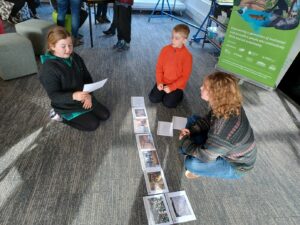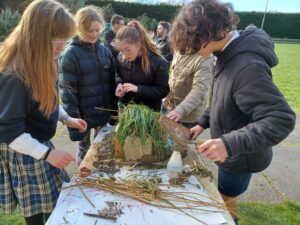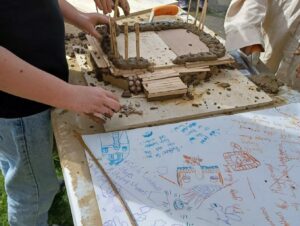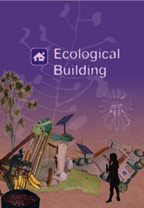Learning to build with Earth
In March 2023 the Enviroschools Otago facilitation team were invited to a workshop on Natural Building Materials and Techniques in Tīrau, Cromwell. Led by Delia Bellaby and Elizabeth Guthrie of Earth Building Association New Zealand (EBANZ), we were taught the art and science of combining clay, sand, straw and water to build robust structures. The experience left us buzzing with excitement to share this knowledge with our schools back home. The following story is how we used these new skills to run a hui on Ecological Building for year 7 – 10 students.
Framing the hui

Using images from the Enviroschools Ecological Building activity “Lifecycle of Building Materials”.
We chose the Enviroschools Ecological Building Theme Area Key Concept “buildings come from nature, and return to nature” to structure and focus the hui. At an earlier hui in Cromwell we had begun our workshop by considering the life cycle of modern building materials. This had been a useful way-in to talking about sustainable building practices. In Dunedin we used the Enviroschools activity and image resource “Life Cycle of Building Materials” to spark this conversation with our students at the hui.
We invited an expert from Cook Brother’s Construction in Dunedin to continue this kōrero. Sustainable Carpenter, Daniel, uses construction waste to build projects for community groups and schools in our region. He told us how his job works to divert waste from landfill, and we got to share times where we had built from materials that we had left over, realising that when you problem-solve, using materials at hand, a really special kind of creativity is ignited, leading to a unique, one-of-a-kind outcome! Daniel was excited to hear teachers talking about possible ways they could re-use the materials from torn down school buildings to create something new on school grounds.
Earth Building

An in-house expert, Scott, Enviroschools facilitator and Earth Builder, shared his knowledge.
We then introduced our focus of building with earth as an ultimate manifestation of the concept of buildings coming from and returning to nature. We are extremely lucky in Otago to have an expert in Earth Building amongst us, Scott Martin, the Clutha District Enviroschools Facilitator, who has spent time overseas learning techniques such as cob and strawbale construction.
Scott shared images and stories from his travels, and we learnt some important construction rules for building with Earth: “good shoes, big hat”. He advised building on a foundation of stone or concrete and to build large eaves to protect your structure from the weather – extremely important for our end of the country, and a good reminder to consider the climate you are building in and for!
Getting our hands dirty
Enough talking! Let’s do it! The next activity was full-on-fun. Each station is an Earth Building technique in action. We had four stations, Cob, Wattle & Daub, Adobe Brick and Rendering onto carpet (carpet provides a textured surface to help the thin clay render stick, second hand carpet is actually used in ecological building!).

Weaving traditional methods with future possibilities – wattle and doab.

Murray constructed miniature adobe brick moulds for the students to use.

Hands-on learning.
Students followed ratios (like recipes) to make the substrate and then learnt the technique. This was a resource-heavy activity and involved a lot of preparation prior to the hui. We are really lucky in Dunedin to have Murray. Murray is the partner of our facilitator Jennie Upton, and someone who gets stuff done. Murray made miniature adobe brick moulds, sourced clay from their land, mixed the clay with sand, cut straw and water to make the adobe, and made 80 adobe bricks for our students to practice building with and to use for their models.
Murray made frames to hold the willow in place for Wattle & Daub and frames to stand the carpet on to practice rendering. Murray taught the rendering station. Murray helped us clean up all the mess at the end of the day… We all need a Murray. If you don’t have a Murray though, EBANZ is a great place to start to enquire about an Earth Building expert in your area who could direct you toward clay pits and perhaps teach you techniques as well!
The students loved these stations, and the day really went up a gear. As at the workshop in Cromwell, we noticed how easily students pick up these techniques, it just seems to come naturally to them, reminding us that our ancestors’ deep connection and knowledge of our natural world lives on in all of us.
Model Making

Exploring ecological building techniques.

Careful consideration of the concept “buildings come from nature and return to nature.”
“We thought this experience was amazing and educationally fun!” – participant feedback of thoughts from the day.

Following the design concepts and plans.
In the lead up to the hui we asked schools to think about ecological buildings at their place. Students had the chance to wonder what they would like to see at their school and where these structures could be made. This was supported by the Enviroschools Ecological Building activity, “Small Building Project Ideas”.
“We can build things other ways to help the world.” – student comment
We took the opportunity to plan a design for these ideas with the support of our sustainable building experts, and the Enviroschools “Exploring Natural Building Design” images for extra inspiration. The plans included site information, purpose of the build, materials and where they could be sourced, and the techniques employed.
“I love the ownership in the building of the garden from this student – sure the permission to go ahead rests with the principal, but they obviously feel they have learnt building skills today!” – comment about the hui
The remainder of the day was spent outside, building models. Students worked together to bring their plans to life. We provided an array of natural materials and students used the clay mixtures from the workstations.
An Otago Daily Time’s article on the hui has some great video footage of the model making in action!
After the hui
Teachers immediately saw connections between what we taught and their curriculum.
“I’d like to do the testing of brick ratios with our students with our resources [locally sourced clay] – be great aspect for science.” – teacher
Many indicated their intention to continue with their ecological build planning or to be a part of more ecological building PLD in the future.
“We could bring these ideas into technology, building classes, including NCEA.” – teacher comment
A couple of schools had previously been seriously considering an ecological build and used the hui to further investigate current ideas and to design their build. These projects include a Wattle & Daub inspired wind break at Pūrākaunui school to protect the butterfly habitat they are making next year, an adobe brick and thatch rooved hut at Warrington School, where the focus is on locally sourcing clay, ongoing development of an outdoor classroom at Waitati School and building a new outdoor classroom on the Urban Farm at Kaikorai Valley College.
We (Enviroschools Otago facilitators) will be supporting schools throughout the planning and building process, working with experts from EBANZ to connect schools with possible funding and expert support. One extended primary school thoughtfully brought year 7 students along so these students can lead the project next year.
 Beyond Dunedin, we are planning to hold an Otago-wide enviro-hut building challenge in 2024. We will reach out to our local experts again with Sustainable Carpenter for Cook Brothers Construction Daniel Roberts, keen to be a part of this challenge, providing schools with both building materials diverted from landfill and building expertise.
Beyond Dunedin, we are planning to hold an Otago-wide enviro-hut building challenge in 2024. We will reach out to our local experts again with Sustainable Carpenter for Cook Brothers Construction Daniel Roberts, keen to be a part of this challenge, providing schools with both building materials diverted from landfill and building expertise.
This hui has reminded us of the joy of building with young people and of building with earth, please get in touch if you are interested in running a similar hui and have any questions.
Tess MacKay and the Enviroschools Otago Team.